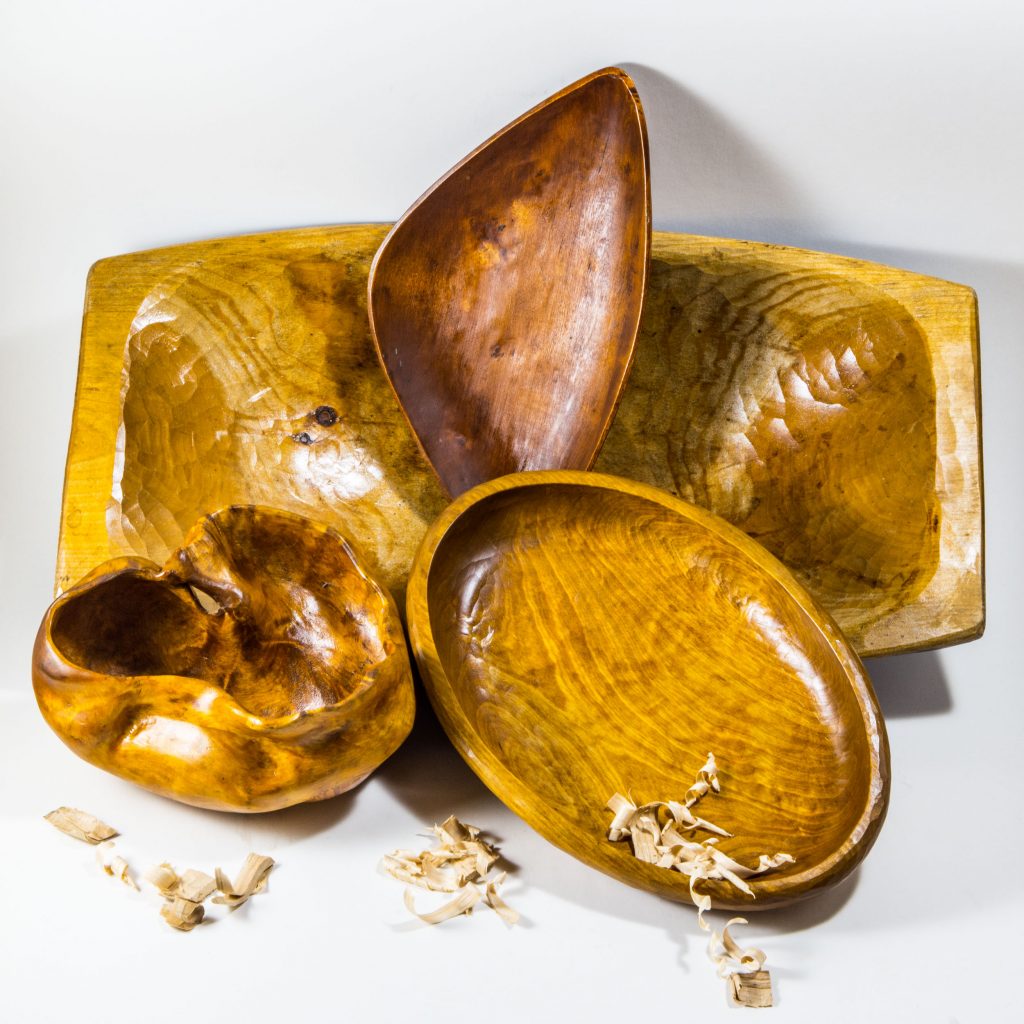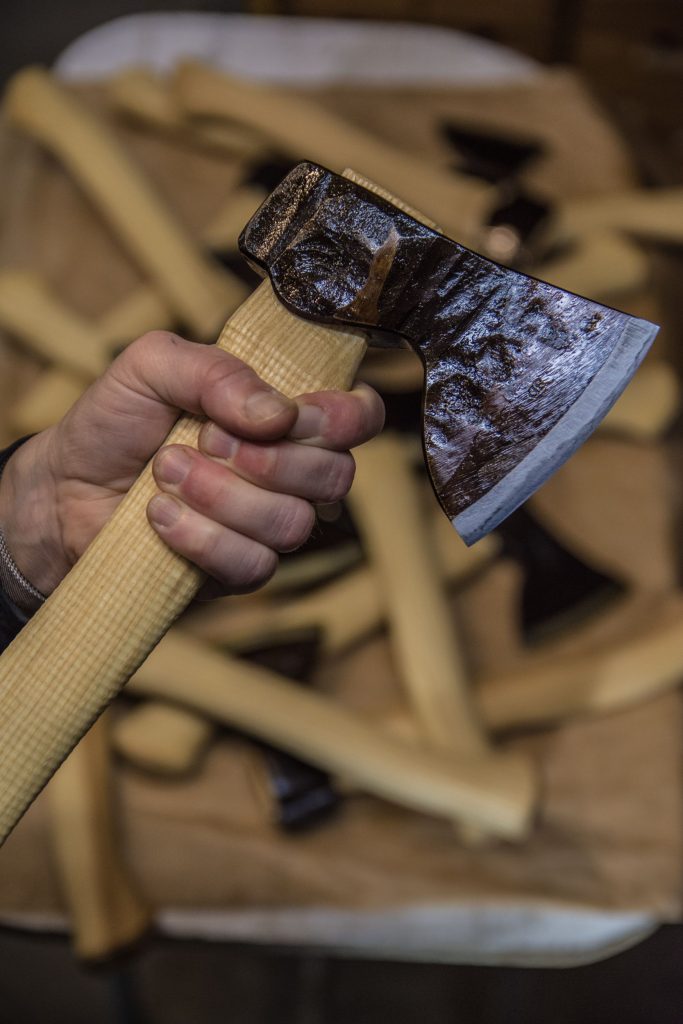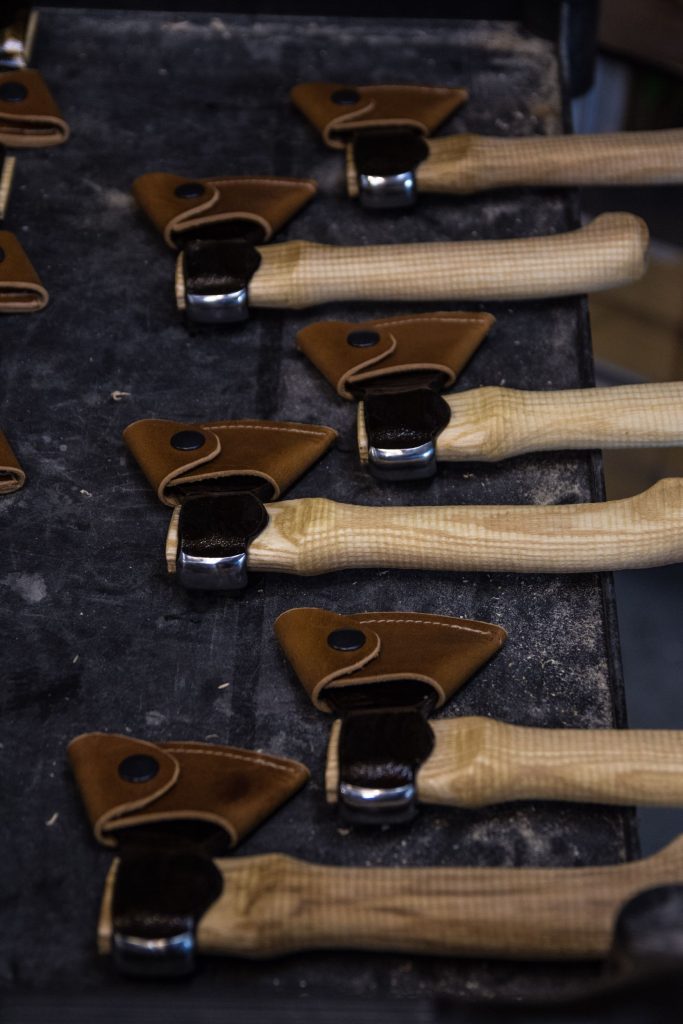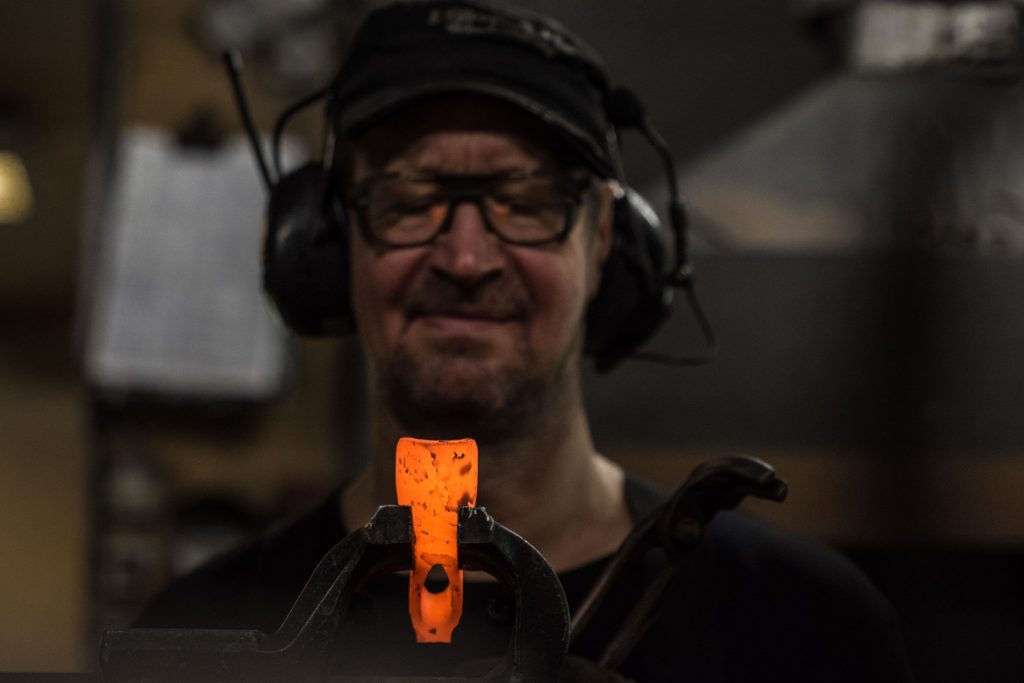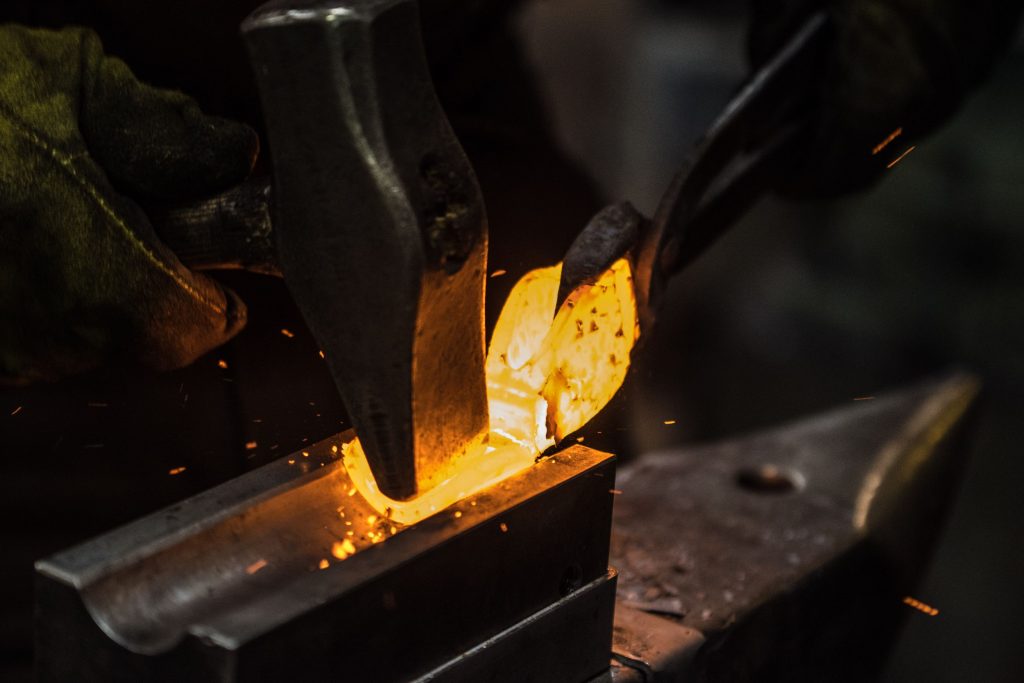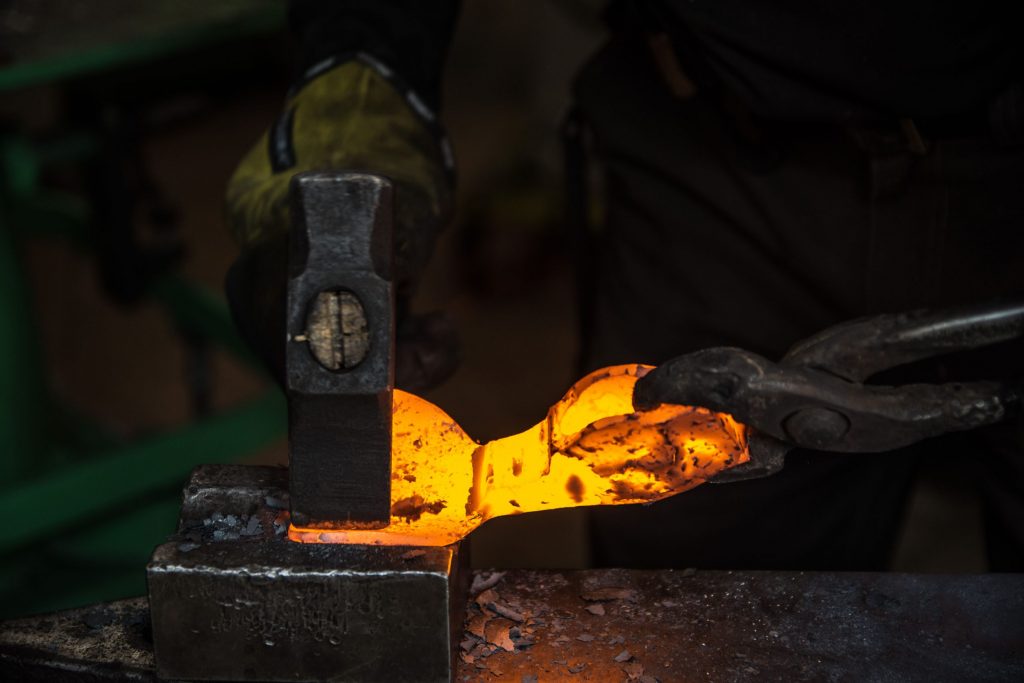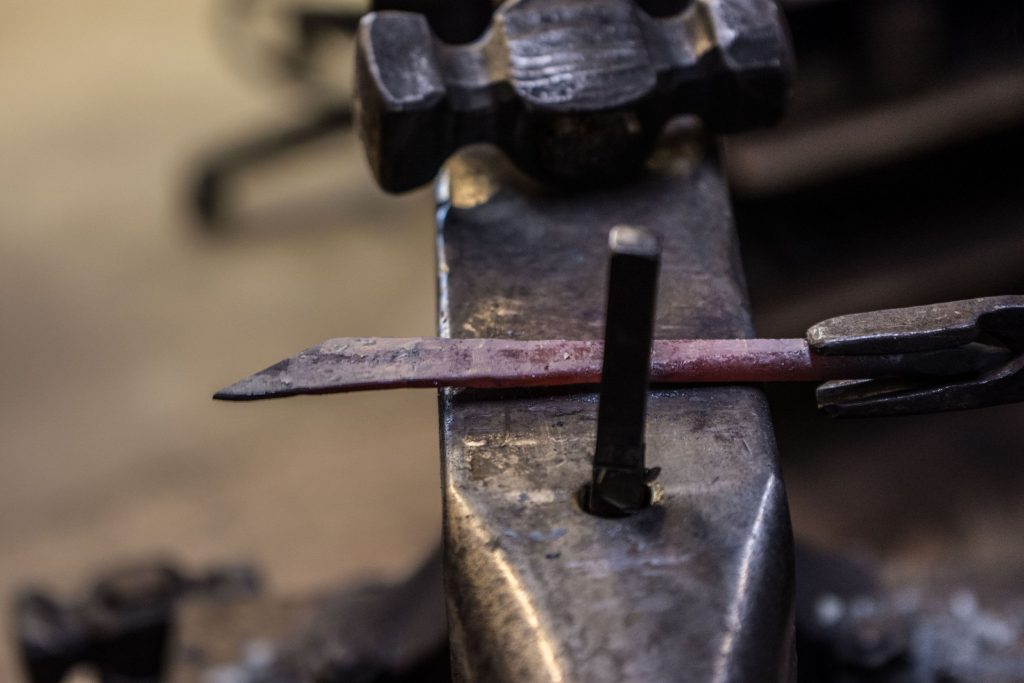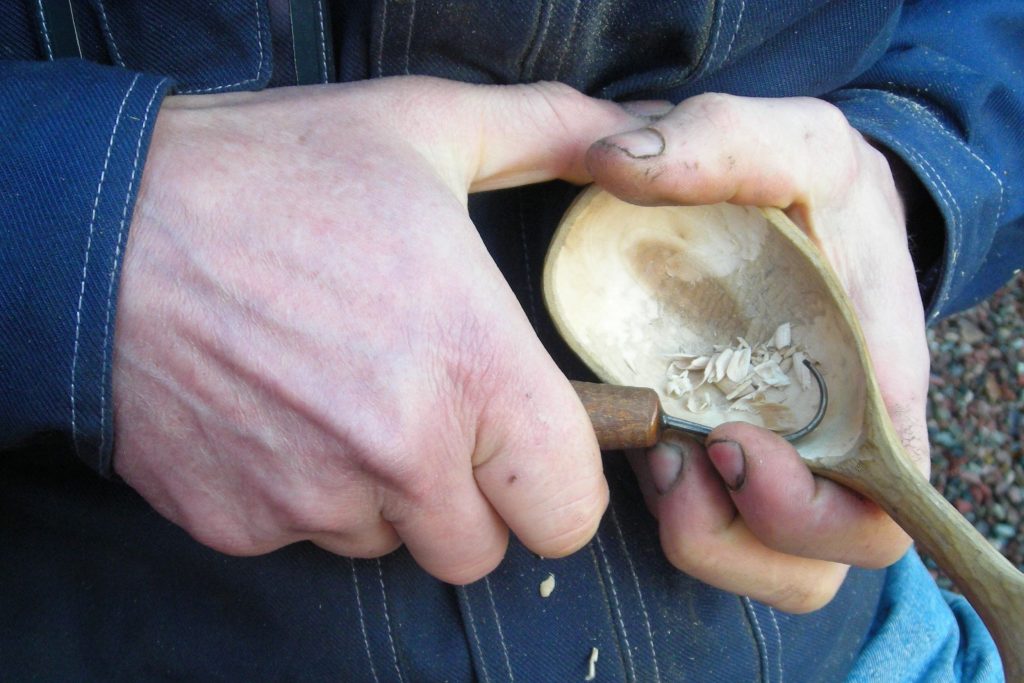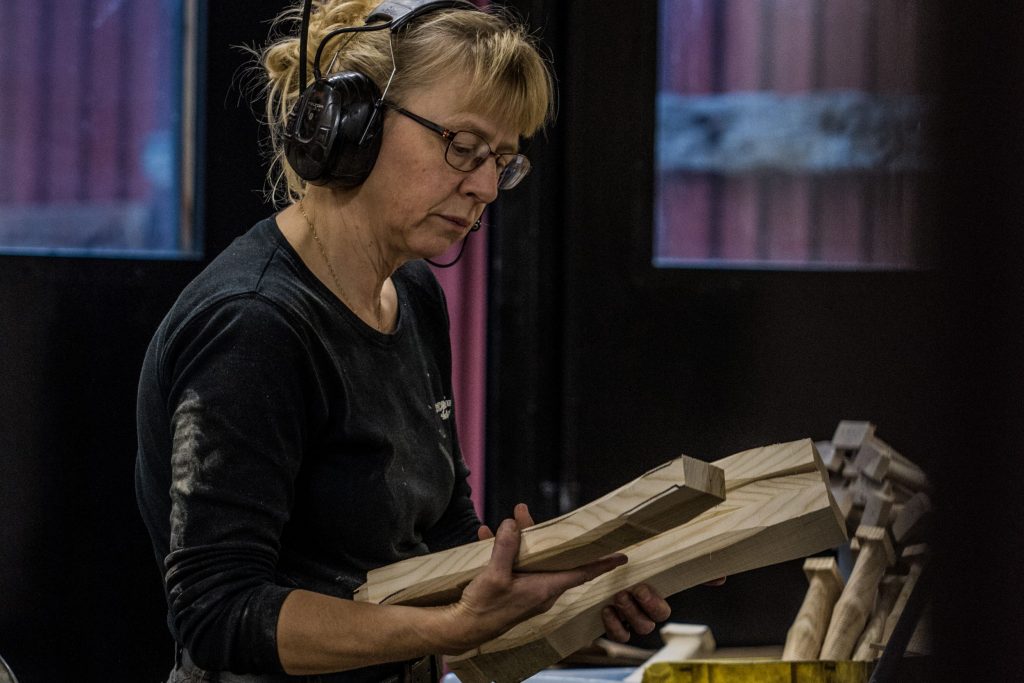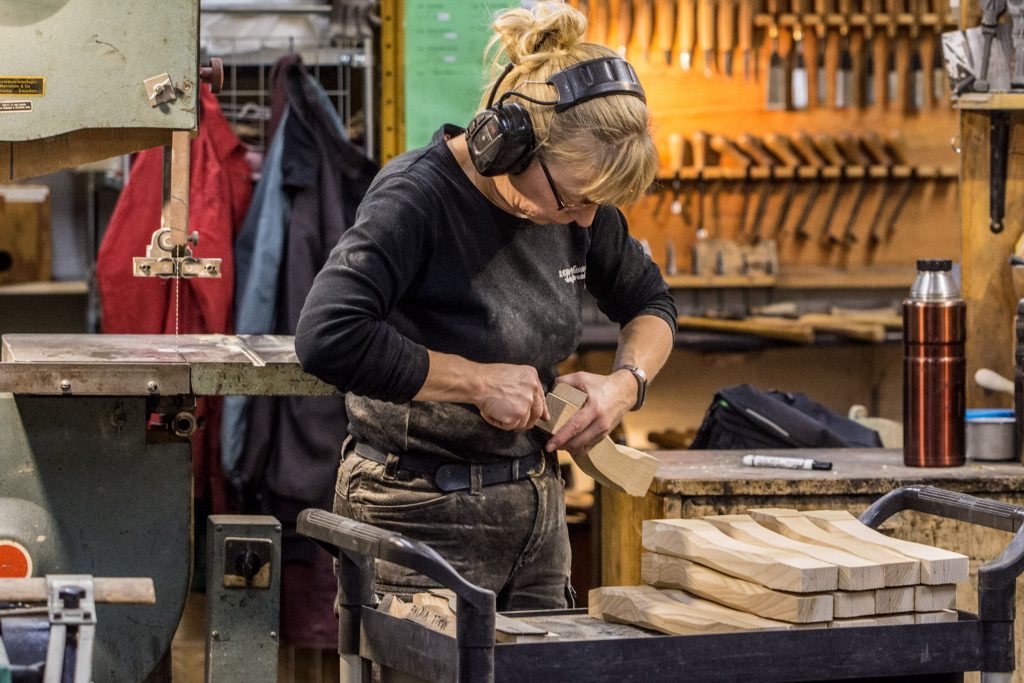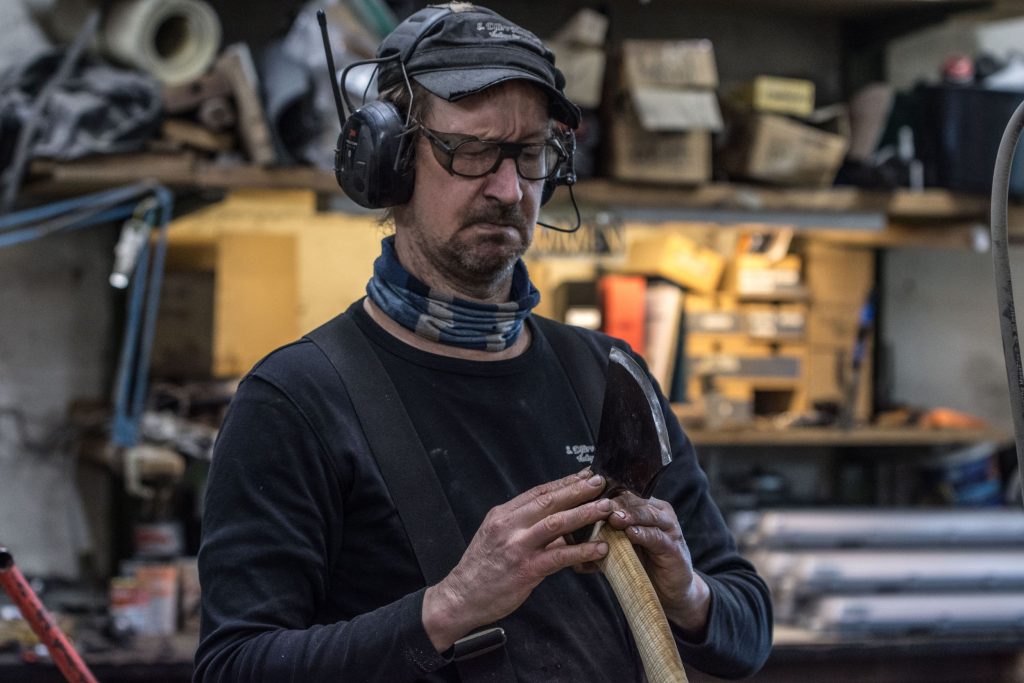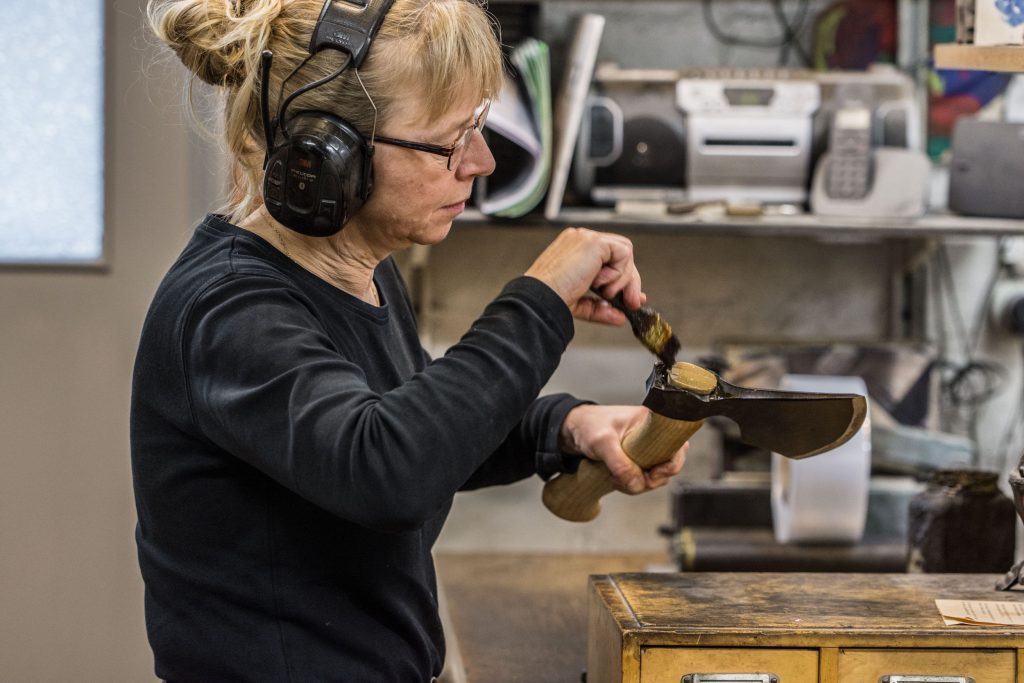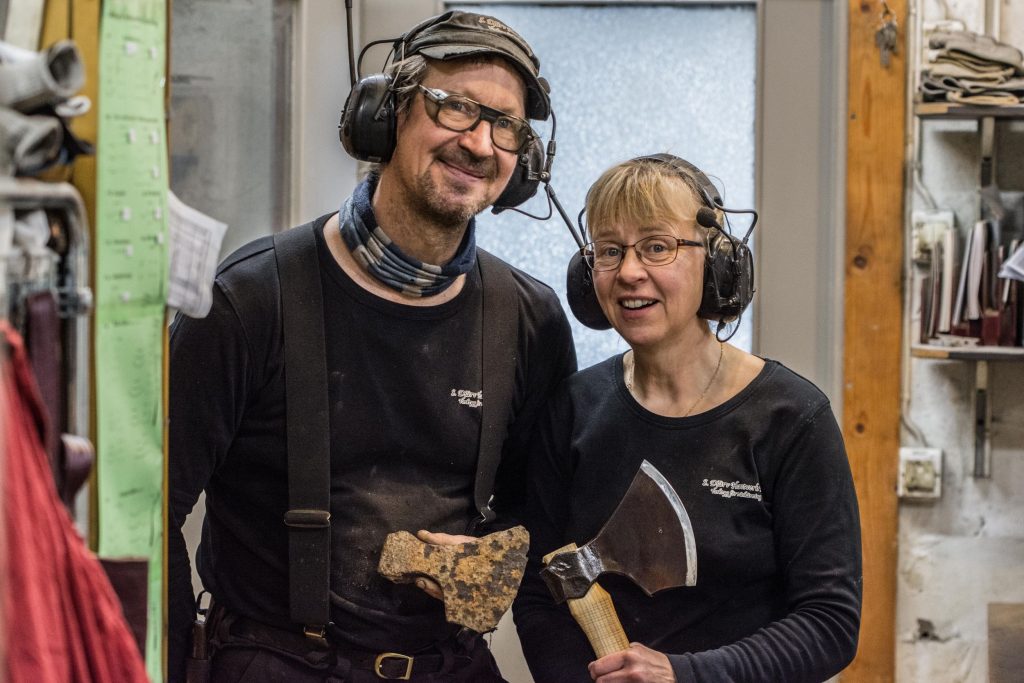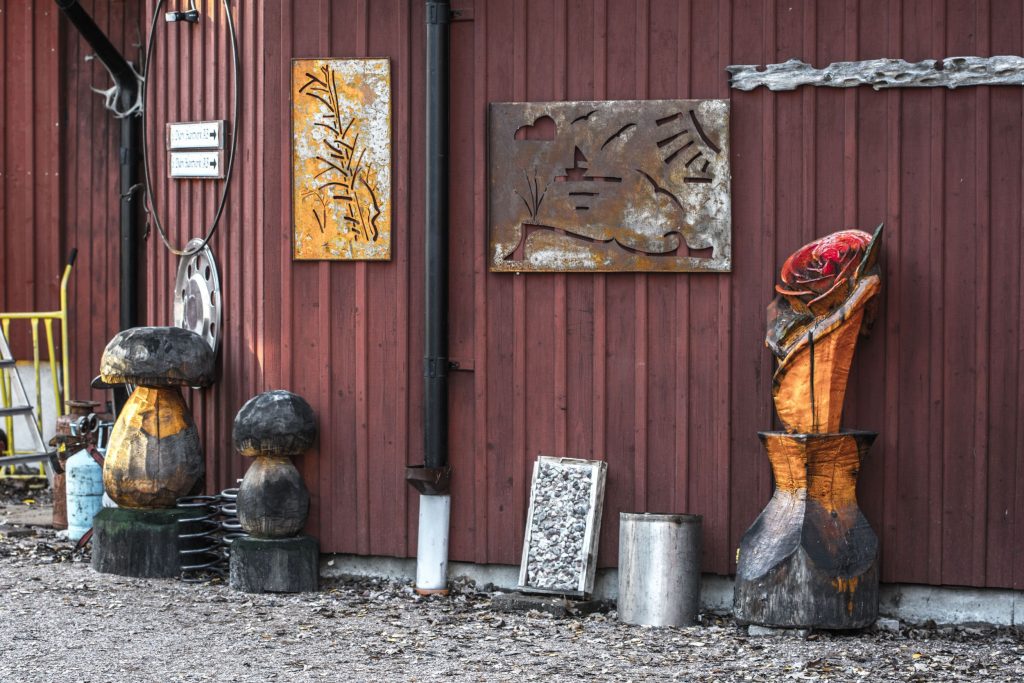Inspiration
In this section we give you some tips and knowledge when using our tools!

Tool hints
We often get questions like: I want to carve a spoon! What tools do I need? With that in mind we have made this long list of different tips of tools to use in different handicraft projects and carving challenges.
Carve a spoon or a ladle
Start with Carving axe 0,75 kg to form the material. Use Carving knife 16×70 mm or 17×60 mm to fine carve the material. The Spoon knife standard is used to form a spoon or ladle. You will find having both a right and left spoon knife very useful. You can use Spoon knife large for fine carving the spoon or ladle. You can also use Carving knife 11×35 mm to make nice details.
To form inside a little bit deeper ladle you can use our Small hooked dogleg gouge (16 cm).
Carve a bowl, spoon or ladle
Start with Carving axe 0,75 kg to form the material. Use Carving knife 16×70 mm or 17×60 mm to fine carve the material. For bigger ladles you can start to cut the inside with the Adze 0,6 kg. To form the bowl, spoon, ladle or trough use Hooked dogleg gouge small (16 cm) or Hooked dogleg gouge (22 cm) (depends on how deep you want the bowl).
Diameter and depth of the bowl decides which size you should have on the gouge. A deep shape of the edge gives a deeper mark and is easier to carve with in the beginning of the work. A level shape is more for fine carving.
You can also use Spoon knife standard and Spoon knife large to shape the inside. You will need both left and right spoon knife. Carving knife 8×50 mm is good to use when you want to form the handle of for example the spoon.
Make a dish, bowl or trough
Adze 0,6 kg, 0,7 kg or 1,3 kg does the hard work on the inside of your project. For a larger troughs and dishes, use a bigger adze. Beating gouge bent or Beating gouge straight (depends on the depth) to use before fine carving.
For the fine carving you use Bent gouge or Straight gouge or Straight upnosed gouge. A deep shape of the edge gives a deeper mark and is easier to carve with in the beginning of the work. A level form is more for fine carving. Drawknife 27 cm or Timber drawknife 32 cm are good tools for shaping the outside.
For children, small hands and small projects
The Children’s carving knife 15×50 mm comes in three models: sharp tip, rounded tip or flat tip. We recommend the model with sharp tip from around 5 years of age, rounded tip from 4 years and flat tip from 3 years. We also have a leather sheath to the the Children’s carving knife.
Our Children’s spoon knife have the same blade as standard, but the handle is smaller. This tool is recommended to a little bit older children (around 10 years) since it is more difficult to work with.
We also have our Children’s carving set that consistst of:
1 x Children’s carving knife (pick your tip)
2 x Children’s spoon knife, right and left
1 x Japanese slipstone, grit 1000
1 x Knife roll
Carving axe 0,4 kg is a light axe to form a material with. Easy to work with since it is not that heavy. Recommended from 10 years of age.
We also have the Splitting iron. A safe way to split material with. You can hit on it with an wood club. Recommended from 10 years of age.
Drawknife 14 cm is together with a Shaving horse excellent tools to form the outside of a material. Recommended from 8 years of age.
All age recommendations are very general and you will always have to make individual decisions depending on the earlier experience of knives and carving. And of course, always let the children craft and carve under supervision of an adult.
For bushcraft
Cutting axe 0,7 kg. A light and flexible axe to cut up wood for the fire. If you want to bring an even lighter and smaller axe, we have our Backpack axe 0,4 kg. This was also the first axe we made a fitting leather sheath for. We have leather sheaths for most of our smaller axes as well.
Carving knife 17×60 mm or 16×70 mm are handy knives for carving or for splitting smaller logs into splinters. We also make a fitting leather sheath.
Of course the Wood carving set is a natural friend in the backpack!
For carving and engraving
Both Engraving knife, oblique shape and Engraving knife, knife shape has double bevels. They work fine both when sculpting and engraving.
Our Mini gouge has a thin blade which gives a good control when making spoons and fine carving work.
The Chip carving knife 8×35 mm has a straight edge and bent spine. The tip of the edge gives very good control.
The Carving knife 11×35 mm and 8×50 mm are two carving knives with thin (which gives short bevels) and pointed blades which gives good control when carving.
Our Mini V-gouge whith its thin turned blade, is an excellent tool for decorating leathersheaths and engraving.
For rough sculpting
Sculpture axe 0,8 kg has almost a straight bevel with marked tips at both the top and bottom
Our Adzes 0,6 kg, 0,7 kg or 1,3 kg (or Adze mini 0,4 kg) for shaping the material. Beating gouge bent or Beating gouge straight are strong tools that you could use to beat with a wooden club.
Timber chisels can also be a big helping hand when sculpting.
Smooth sculpting or carving images
We have a wide range of Straight gouges and Straight chisels. They come in many shapes and sizes, all of them can be helpful, depending on what type of project you are up to.
Make your own knife
If you want to make your own handle you can still use a Knife blade from S. Djärv Hantverk. We have 9 different sizes on our knife blades, they are all forged from round tool steel material.
The blade is forged by hand and is therefore not entirely flat. Beware when fastening it in a vice. Also be careful when striking on the handle. When ordering our knife blades separately, they are delivered rough grinded.
Wood turning
These wood turning tools for cutting work is a set of tools that will take you very far in your wood turning projects.
Turning chisels: Pointed chisel 33 cm and Skew chisel 38 cm, very useful tools.
Turning Gouges: Our larger Turning gouge (37 cm / 25 mm) has a round shaped edge. Middle sized Turning gouge (31 cm / 20 mm) and our small Turning gouge (28 cm / 14 mm) has a point shaped edge.
Turning hooks: We have a set of three turning hooks, our small Turning hook 36 cm / 8 mm (outer bevel), the middle sized Turning hook 36 cm / 12 mm (outer and inner bevel) and our large Turning hook 42 cm / 18 mm (outer bevel).
Turning hooked gouge 35 cm: A steady complement to the turning hooks, but you shouldn’t use it for smaller things.
Tools for timbering
All these tools are very strong and developed in cooperation with practising timbermen and -women.
You can use our Timber axe 1,6 kg to shape the material. It is comes with a right, right-right, left or straight handle.
We also have our large Timber axe 2,4 kg with a single side bevel (right or left). It can also be used as a combined axe and large chisel.
Cutting axe 1,8 kg. It is an heavy axe that you could use for example when you want to cut inside the timber corner.
Timber chisel is also used when you want to shape the inside of the timber corner.
Timber drawknife 32 cm is an excellent tool to shape and bark the log. It has a nice balance to it, that is kind to your wrists when working a lot.
Narrow axe 1,9 kg is similar to the timber chisel, but in the shape of an axe.
Getting started with wood craft and carving
And our last tool hint, that might have been the first. “How do I get started?”. We will assume that you start with a large piece of wood. To start with you need something to remove a lot of material, regardless of what you will make later on. For example an axe, adze, drawknife, beating chisel or beating gouge. Or maybe a splitting iron to get going.
A good knife is always useful. Our Carving knife 17×60 mm or 16×70 mm are very good to cut off a lot of material. When cutting off smaller amounts of wood we recommend the Carving knife 11×35 mm or 8×50 mm. They have more shallow bevels for increased strength and stability. Our Chip carving knife is good for engraving and small work.
To reach the depths in spoons and bowls our Spoon knives are fun tools to use. We make them in many models, but with our Spoon knife standard, right and left, you will get far. You will quickly realise that you need both right and left for optimum reach.
Our Wood carving set comes with Carving knife 17×60 mm, Spoon knife standard right and left, and our Chip carving knife 8×35 mm. The set also comes with a Japanese slipstone grit 1000 along with the Knife roll. This is an excellent set of tools to start with.
For sculpting our gouges and chisels are excellent friends. For example Straight gouge, Bent gouge and Straight chisel. Our tools in the Small wood sculpting set can stand some light beating, but not with a wooden club. If you need to beat the tool you should use our Beating chisels or Beating gouges.
When making bowls and dishes you will also need gouges. For flat trays you can use the Straight gouge, but otherwise the Bent gouge is more useful for creating more depth into the trough or bowl. Of course the Adze is best to start off with. For shaping the outside one of our Drawknives are smart tools to use.
In general when it comes to using gouges it is usually best to start off with a more cupshaped gouge and finishing with a flatter one. A gouge with a deep cup shape, for example with diameter 20, 30 or 40 mm will cut off more material with less effort. It will leave deeper marks in the wood which is why you can use a flatter gouge in the end to make smooth finish, for example with diameter 70, 100 or 200 mm.
Sharpening your knife
Please enjoy a post from our tool smith Svante Djärv, regarding how to keep you tools sharp in the best way.

Sharp edges on knives and axes have been interested to me since the 1980’s. I have also had the possibility to learn more in the subject, and I have discovered that sharp edges is a large and complex topic. There is no quick and easy answer on how to keep your edges sharp.
To make things a bit simpler, let’s just talk about the sharpening process of a carving knife. A sharp edge will appear when two smooth surfaces meet each other, with an angle between. If the surfaces are smoother, the edge will be sharper.
A sharp edge depends on multiple things:
- Difference between sharpening/grinding and polishing/honing
- Bevel angle
- Type of bevel
- The quality of the steel
- The hand holding the knife
- Type of work that the knife will do
When we are talking about a standard carving knife, the bevel angle is very important. At normal use and with a good quality steel, it should be between 25-27 degrees. The shape of the bevel is also of high importance. It should be completely flat, for most support against the material.
Grinding technique
Good sharpening and honing technique require a lot of practice. There are many different known methods, but regardless of which one you use it is most important that you practice it a lot.
Some vocabulary
By sharpening or grinding we mean processing the steel with usually a grinding machine, like either an emery disc, grindstone or belt grinder. All of these have different properties. Personally, I prefer the belt grinder for fine sharpening. First you grind a raw edge that you eventually remove, when the bevel angle and edge alignment is correct.
Finish
In order make the edge as sharp as it can possibly get you need to hone or polish the edge of the blade. When honing a knife, we mean using a fine slipstone, whetstone or similar. Personally, I use a polishing disc made of wool, combined with polishing wax. Instead of a slipstone or whetstone I prefer to use a rotating slipstone. It is quite difficult to use, which doesn’t make it a good option for beginners. You can also use a leather strop to get that last sharpness.
When your knife gets dull after use, you can always hone it to make it sharp again. But when honing a lot, the bevel angle gets wider. Therefore, you need to sharpen or regrind the knife to get the knife back to its original angle.
Lastly
I will clarify a few things. You can sharpen and polish a piece of iron and make it completely razor sharp. But when you start carving with it you will quickly realize that the durability is not the best. The durability of the edge is a big quality factor. We are working with tool steel controlled according to the Swedish Institute for Standards (SIS), which we heat treat in our furnaces and ovens at four different occasions for highest quality, where hardening is one of the steps. We make edges that are hard, tough and durable. They will stay sharp for around 10-100 hours of continuous carving, depending on material and technique. The edge will stay sharp the longest if you are a good carver and carving in raw wood, especially like soft linden / lime wood. The edge will not stay sharp for very long if you are carving in old and dry oak-wood, especially if your technique is bad and you are scraping instead of carving.
This piece of text is very general, and there is a lot more material out there to immerse yourself into.
Please let us know if you have any questions.
Best regards /the tool smith
An offer to our customers
Even though our tools are very durable and stays sharp for a long time, they will eventually get dull. We know that for example the spoon knife can be slightly difficult to sharpen and hone, we offer to help you with that. Apart from the spoon knife we can also sharpen and hone other tools that we have made. We might be able to make exceptions and sharpen/hone tools made by others. Please let us know what type of tool you want us to sharpen before you send it to us, and we will make an assessment if we can accept the challenge or not.
The price can vary and is dependent upon the size of the tool and how damaged the edge is. We send the tool back to you as soon as we are done, together with an invoice for the work and the return shipping fee.
Click the button below to see all our products related to sharpening, honing among with general maintenance and storing of your knives.
Tool making methods
We make all tools by hand, and we use only high quality material.

We make our tools from quality assured steel material. This means that on every single tool we are heat treating, we have over 30 years of experience on that particular kind of steel / alloy (mix of different steel substances). The different kinds of alloys are there to improve different properties of the steel. For example, toughness, durability and hardness. We do all the heat treatments by ourselves to keep track of the edge quality throughout the full manufacturing process.
Most of our tools are heat treated in an oven four times, including the forging itself, through different processes like for example releasing tension by annealing, hardening, and tempering. Most of the heat treatments takes many hours with exact temperature to achieve maximum quality. All processes are being monitored carefully, where all parts of the process are equally important for the end result.
Our ovens and furnaces give us an even and well monitored heat for the different heat treatments, which enables the highest quality.
Mostly we use steel with the designations SS 2258, 2140, 2090, 1672. The hardness of our tools is measured according to the Rockwell scale (HRC) where the hardness is a bit different depending on the tool we make. But usually, the hardness is around 59 to 61 HRC.
We forge our tools manually. Usually, we take some help by a machine hammer. But of course, we use the classic anvil and hammer a lot.
All our axes are made with the edge in the middle. Symmetrical bevels, which means that the bevels have the same length. All grinding and honing are made on freehand. The bevel angle is around 27-28 degrees. The axe head is put on the handle with glue and a wedge. We use a hydraulic press with around 1000 kg’s of power to push down the wedge. This is the best way to fasten the axe head to the handle.
We forge the shape of our knife edges on freehand. The grinding is also made completely by hand, with a bevel angle at around 25-27 degrees. The handle is drilled and the tang is pushed down into the handle, together with glue.
We make our handles by hand to have full control of the quality. We use only Swedish hardwood like elm and ash. All handles are soaked in linseed oil and we let them drip dry.
When our tools are all done and ready for delivery, we send them to you well protected in padded packages and envelopes. All the sharp edges are dipped into a certain protective plastic so that they stay sharp all the way to you. Some tools get taped edges instead, like our drawknives.
Pictures from S. Djärv Hantverk AB
Please enjoy some inspiring pictures from our workshop. Do you have a beatiful picture of when you are using our tools? Feel free to email it to us and it might end up here!
The Workshop
Creations
Tools
Forging
Wood craft
Making knife blades
Making axe handles
Our place
Pictures from S. Djärv Hantverk AB
Please enjoy some inspiring pictures from our workshop. Do you have a beatiful picture of when you are using our tools? Feel free to email it to us and it might end up here!








